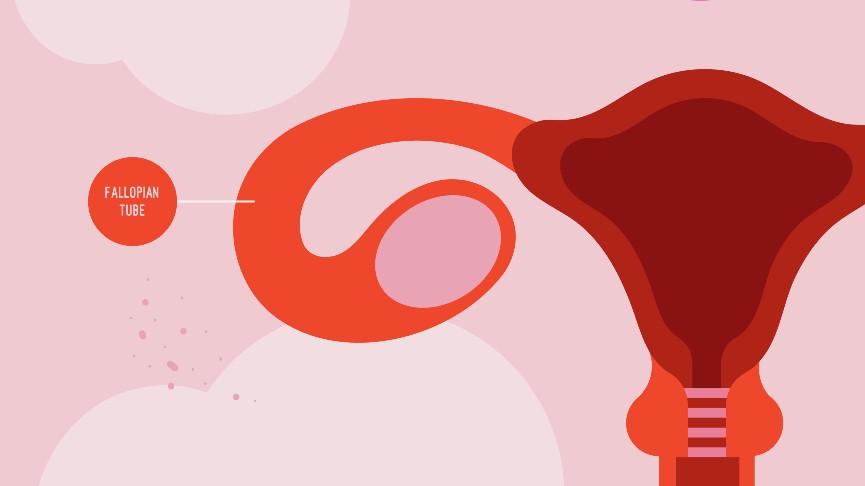Let’s Learn About Fallopian Tubes

You’ve heard of fallopian tubes, sometimes called uterine tubes, one part of the fascinating work of machinery that is the female body. You know they have something to do with human reproduction, and play a part in your monthly cycle – please don’t hold it against them.
With so much talk about the uterus, vagina, and cervix, your sweet fallopian tubes don’t get enough attention!
Well, today’s your day, fallopian tubes! Let’s learn all about them. The role they play in the reproductive cycle, how they function, and conditions that can affect them. Tubular!
What is The Fallopian Tubes?
The best things come in pairs, and the same is (usually) true for the fallopian tubes. Some people may only have one due to a biological abnormality or after removal for certain conditions, but we’ll get to that later.
Back to the basics.
These J-shaped tubes extend out from the uterus, opening near the ovaries into the abdominal cavity. Just like the subway tube, your fallopian tubes are the transportation system of your reproductive tract. They transport mature female reproductive cells, ovum, from the ovary to the uterus. Each tube is about half an inch in diameter and ten to thirteen centimeters long.
The fallopian tubes are made up of four parts. The fimbria captures the ovum from the surface of the ovary and looks like funny little fingers. Attached to them is the funnel-shaped infundibulum. Keep moving around from there and you reach the ampulla, the widest and longest section of the tubes, and where fertilization typically happens. Finally, connecting the ampulla to the uterus is the isthmus. What a wild ride!
With a little help from sex hormones like oestrogen, the smooth muscle layer of the fallopian tubes supplies the ovum with nutrients as it helps to move it towards the uterus. Once it hits the uterus, the egg is either shed during menstruation or if fertilized, implanted in the uterus to start the journey of pregnancy.
The slippery mucuous membrane lining of the fallopian tubes has secretions that help keep the sperm and egg alive on their precarious journey through the reproductive tract. Other nutrients like lactic acid, glucose, and bicarbonates help the fertilized egg to develop and create a comfortable environment for fertilization to happen in the first place.
When an egg is released each cycle, whether or not it’s fertilized, it takes about three to four days to reach the uterus as it makes its way through a fallopian tube.
Fallopian Tube Issues
Ectopic Pregnancy
One of the most well-known fallopian tube complications is an ectopic pregnancy.
About 1.9% of reported pregnancies are ectopic, or when the fertilized egg implants itself somewhere other than the uterus. The most common area for this to happen is in the fallopian tubes. Some ectopic pregnancies will correct themselves on their own, while others will need medical management or termination.
Salpingitis
Salpingitis, a form of Pelvic Inflammatory Disease (PID) causes inflammation in the fallopian tubes that can lead to long-term complications and fertility issues if left untreated.
It is usually caused by a bacterial infection, typically from an STI like gonorrhea or chlamydia. Typically treated with antibiotics and surgery when necessary, to help prevent long term complications by getting regular STI testing and watching for signs of infection like:
- Fever, vomiting, and nausea
- Yellow or foul-smelling vaginal discharge
- Abdominal or dull lower back pain
- Pain during menstruation, sex, or ovulation
Endometriosis
Endometriosis is a painful condition that happens when the lining of the uterus, endometrium, grows outside of it, in places that it shouldn’t.
Over time, this tissue can scar and block the fallopian tubes, which can lead to fertility problems and difficulty conceiving. This can sometimes be corrected surgically. In other cases, specialists will recommend bypassing the fallopian tubes during conception by fertility treatments like in vitro fertilization, IVF.
Birth Defects
While they are pretty rare, there are certain congenital abnormalities that can affect people’s fallopian tubes.
This could look like having one or both tubes blocked, which may or may not be able to be surgically corrected. This condition may go undetected until someone hits fertility issues.
People who are at a higher risk of congenital fallopian tube issues are those who have been exposed to the chemical diethylstilbestrol in utero or people who have Müllerian duct maldevelopment.
Are These The Tubes That Get Tied?
You guessed it!
When people opt for sterilization as a method of permanent birth control, it typically involves cutting the fallopian tubes so that ovum can’t make it into the uterus.
People typically need to undergo counseling and meet certain criteria before they can get this procedure done. Some even choose to do it in the postpartum period shortly after birth.
You made it through the wild ride of the fallopian tubes! Ready to learn more about your anatomy? The next stop on the reproductive education train is the cervix. All aboard!

Natasha (she/her) is a full-spectrum doula and health+wellness copywriter. Her work focuses on deconstructing the shame, stigma, and barriers people carry around birth, sex, health, and beyond, to help people navigate through their lives with more education and empowerment. You can connect with Natasha on IG @natasha.s.weiss.


